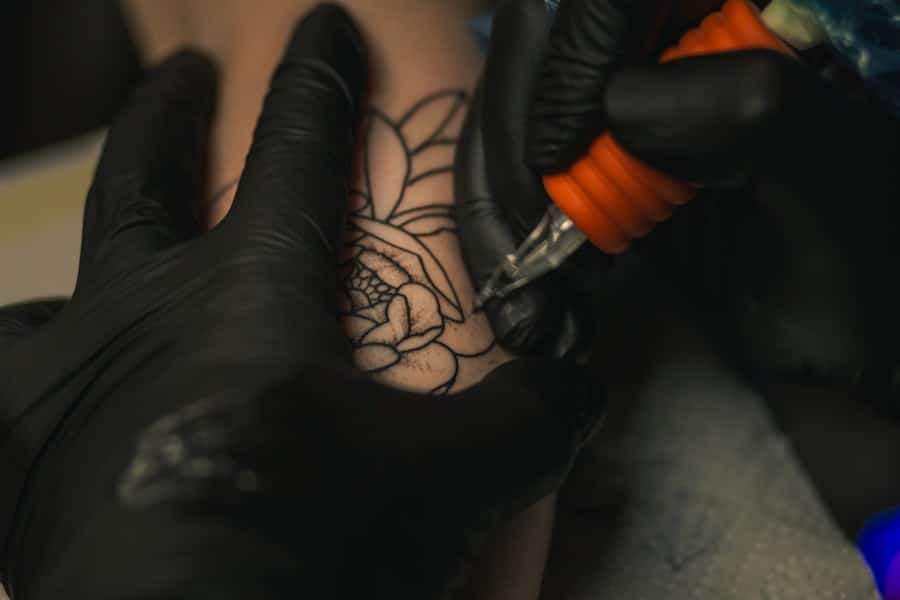Augmented Reality (AR) tattoos represent a fascinating intersection of technology and body art, merging the permanence of traditional tattoos with the dynamic capabilities of digital media. This innovative concept allows individuals to enhance their inked designs with animated visuals, interactive elements, and even sound, creating a multi-dimensional experience that transcends the limitations of conventional tattoos. As the tattoo industry evolves, AR tattoos are emerging as a novel form of self-expression, appealing to tech-savvy individuals who seek to personalize their body art in ways previously unimaginable.
The allure of AR tattoos lies not only in their aesthetic appeal but also in their potential to revolutionize how we perceive and interact with body art. By integrating digital overlays with physical tattoos, artists and clients can collaborate to create unique pieces that tell a story or convey a message beyond the static image. This fusion of art and technology opens up new avenues for creativity, allowing for a more immersive experience that can change over time, reflecting the wearer’s journey or mood.
As we delve deeper into the world of AR tattoos, it becomes clear that this trend is not merely a passing fad but a significant development in both the tattoo and tech industries.
Key Takeaways
- AR tattoos combine traditional body art with augmented reality technology
- AR technology has the potential to revolutionize the tattoo industry
- AR tattoos work by overlaying digital content onto the physical tattoo using a smartphone or AR glasses
- The benefits of AR tattoos include enhanced personalization, interactive designs, and the ability to change the tattoo’s appearance
- The future of AR tattoos in the fashion and entertainment industries is promising, but concerns about privacy and security need to be addressed
The Potential of AR Technology in the Tattoo Industry
The tattoo industry has long been characterized by its rich history and cultural significance, yet it has also been slow to adopt new technologies. However, the advent of AR technology presents an opportunity for tattoo artists and enthusiasts to explore uncharted territories. With AR, tattoos can evolve from static images into living artworks that can be altered or animated through digital applications.
This capability not only enhances the visual appeal of tattoos but also allows for a deeper connection between the wearer and their body art. For instance, imagine a tattoo of a butterfly that flutters its wings when viewed through an AR app. This transformation can evoke emotions and memories associated with the design, making the tattoo more than just an image; it becomes an interactive experience.
Furthermore, AR technology can facilitate virtual try-ons, enabling clients to visualize how different designs will look on their skin before committing to a permanent ink. This feature could significantly reduce regret and dissatisfaction, which are common concerns in traditional tattooing.
How AR Tattoos Work

AR tattoos function through a combination of specialized ink, digital applications, and augmented reality technology. The process begins with a traditional tattoo artist creating a design on the skin using conventional tattooing techniques. Once the tattoo is complete, the wearer can use an AR application on their smartphone or tablet to scan the tattoo.
The app recognizes the specific design and overlays digital content onto it, which can include animations, videos, or interactive elements.
Once recognized, the app triggers the corresponding digital content to appear on the screen.
This interaction creates an illusion where the tattoo seems to come alive, providing an engaging experience for both the wearer and observers. Some artists are even experimenting with using special inks that can enhance the visibility of AR effects under certain lighting conditions, further expanding the possibilities for creative expression.
The Benefits of AR Tattoos
One of the most significant benefits of AR tattoos is their ability to offer a personalized experience that evolves over time. Unlike traditional tattoos that remain static, AR tattoos can be updated with new content or animations as the wearer’s interests change. This adaptability allows individuals to keep their body art fresh and relevant throughout their lives.
For example, a person might start with a simple design that later incorporates new elements representing milestones or achievements. Additionally, AR tattoos can serve as a powerful tool for storytelling. They enable wearers to share their narratives in a visually compelling way, allowing friends and family to engage with their stories through interactive experiences.
This aspect is particularly appealing in social settings where individuals can showcase their tattoos and share the accompanying digital content with others. The ability to connect on a deeper level through body art fosters community and understanding among diverse groups of people.
The Future of AR Tattoos in the Fashion and Entertainment Industries
As AR technology continues to advance, its integration into the fashion and entertainment industries is becoming increasingly apparent. Designers are beginning to explore how AR tattoos can complement clothing lines and accessories, creating cohesive looks that blend physical and digital elements. For instance, fashion shows could feature models adorned with AR tattoos that change in response to music or lighting, enhancing the overall aesthetic experience for audiences.
In the entertainment sector, AR tattoos could play a role in marketing campaigns or promotional events. Imagine attending a concert where performers have AR tattoos that interact with the audience’s devices, creating an immersive experience that blurs the lines between performer and spectator. This innovative approach could redefine how artists connect with their fans, offering unique ways to engage with their work beyond traditional merchandise or social media interactions.
Concerns and Risks Associated with AR Tattoos

Despite their exciting potential, AR tattoos also raise several concerns and risks that must be addressed as this technology develops. One significant issue is privacy; as AR tattoos often rely on apps that collect user data for personalization purposes, there is a risk of sensitive information being misused or exposed. Wearers must be cautious about which applications they use and how their data is handled by developers.
Moreover, there are health considerations associated with combining technology with body art. The long-term effects of using special inks designed for AR applications are still largely unknown. While traditional tattoo inks have been studied extensively, the introduction of new materials raises questions about skin reactions and potential allergic responses.
It is crucial for artists and clients alike to prioritize safety by ensuring that any products used are tested and approved for skin contact.
The Role of AR Tattoos in Self-Expression and Personalization
AR tattoos offer an unprecedented level of personalization that resonates deeply with contemporary notions of self-expression. In an era where individuality is celebrated, these dynamic designs allow wearers to curate their body art in ways that reflect their unique identities and experiences. The ability to incorporate personal stories or interests into an ever-evolving tattoo design empowers individuals to express themselves authentically.
Furthermore, AR tattoos can facilitate connections among communities with shared interests or values. For example, fans of a particular franchise might choose similar designs that come alive through AR technology, fostering camaraderie among wearers. This shared experience can create bonds that transcend geographical boundaries, as individuals connect over their love for specific themes or narratives represented in their tattoos.
The Impact of AR Tattoos on the Tech and Fashion Worlds
The emergence of AR tattoos signifies a transformative moment in both the tech and fashion industries, challenging traditional notions of body art while embracing innovation. As this technology continues to evolve, it will undoubtedly influence how we perceive self-expression and personalization in our lives. The fusion of art and technology not only enhances individual creativity but also fosters community connections through shared experiences.
As we look ahead, it is essential for artists, technologists, and consumers to navigate this new landscape thoughtfully. By addressing concerns related to privacy and health while embracing the potential for creativity and connection, we can ensure that AR tattoos become a meaningful addition to our cultural fabric rather than just a fleeting trend. The future holds exciting possibilities for this unique blend of artistry and technology, promising to reshape our understanding of what it means to wear our stories on our skin.
In the rapidly evolving world of technology, augmented reality (AR) tattoos are emerging as a fascinating trend, blending art with digital innovation. This concept is part of a broader movement where technology is increasingly integrated into everyday life, much like the ambitious multimedia efforts seen in other tech domains.


